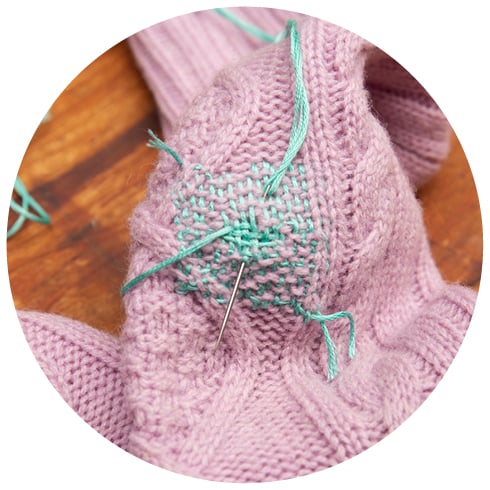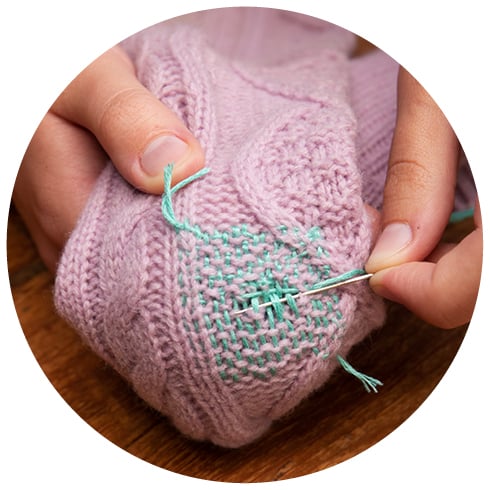General wear and tear doesn’t have to mean parting with your favourite knits. There are lots of ways to easily repair your knits to keep them in your wardrobe for longer, but the most common method for socks is darning. Learn how to darn your socks and not only will your toes stay toasty, but you can use the same technique to sew a hole in your other knitwear. All our wool jumpers and cardigans come with a handy repair kit of spare yarn to mend and give them a new lease of life.

How to Darn a Sock
You Will Need:
• A worn-out sock
• A needle
• A round object (can be a darning mushroom, darning egg, or household object like a jar)
• Thread that matches the thickness of the sock
Traditional Darning: Step by Step

1. Turn your sock inside out and centre the round object under the hole.
2. Starting 1cm away from the hole, create a small grid of lines by going over and then under the fabric. Go through the loops in the knit – also known as the ‘wales’ of the fabric.
3. Let your threads go across the hole as you go.
4. After covering the area with parallel lines, create another set of vertical lines at a right angle.
5. When you reach the edges of the open hole, go over and under the first set of threads to weave new fabric in the space.
6. Once finished, you can tuck the ends in and remove any loose threads.
Expert Tips for Darning
Like with most things, the more you do it the better you will get at sewing up a hole. We recommend darning as soon as your clothes begin to wear thin before the holes grow even bigger.
The Right Tools Make a Big Difference
• Standard hand-sewing thread is often too thin to create a strong mend, so use yarn or embroidery thread with the same thickness as the clothing material.
• Use a darning needle when repairing your knitwear as it’s thicker than an average needle and has a rounded tip. This makes it much easier to weave over and under strands without piercing the thread.
• A thimble can protect you from injuries as well as help push the needle through the fabric.
• When stitching, avoid pulling too tightly as this can pucker the fabric.

Tricks of the Trade
• Tidy up any loose threads around the hole before starting so they don’t get in the way.
• Turn the damaged garment inside out while you repair it.
• For large holes, use a darning egg, mushroom, or round object like the bottom of a jar for support.
• Begin darning a good distance away from the hole to reinforce the thin parts.
It’s Worth it to Repair and Reuse Your Clothing
By darning your sweaters and taking good Care Of Your Knits you can wear your favourite pieces for longer. This will also slow down the amount of fashion you consume and help Care For The Planet. Clothing production doubled between 2000 and 2014 with a growing interest in fast fashion and a throwaway culture. Caring, repairing and reusing clothing for longer helps reduce textile waste that gets burned or goes to landfill, carbon emissions, and wastewater, helping the environment. [1]
Sew up a hole in Your WoolOvers Jumpers Without it Showing
All our jumpers and cardigans come with a repair kit that includes extra yarn and a spare button. Not only will the colour match exactly, but so will the thickness and Type Of Natural Yarns allowing you to create an invisible mend. We know that woollen knitwear can be vulnerable to moth holes as well as general wear, but that doesn’t mean you have to say goodbye to your much-loved sweater.


Add Some Colour with a Visible Mend
Matching the repair yarn to a colour in the knit helps it blend in, but sometimes a different colour for sewing a hole is the only option. Using a contrasting colour in the right place shows off your handiwork and adds a pop of colour. Or pick two different colours for yarn and create a chequered weave. You can also embellish a small hole by adding a flower, a bee, a star - or even a sheep!
(1) Data taken from United Nations Website